In This Article:
Transportation and Structures
Animals and Fantasy
People
Natural Items
Spiritual and Scary
Playing in sand is therapy? What is sandplay?
This article will use “Sandtray therapy” and “Sandplay” interchangeably. Sandplay is a therapeutic modality while Sandtrays are used more typically as interventions paired with play therapy or verbal therapy. This intervention and modality can be used with adults, teens, and children as a projective technique.
Sandplay is a hands-on form of therapy that facilitates the psyche’s natural healing ability by providing a safe space and appropriate symbols to create a concrete manifestation of a person’s internal symbolic world. It is often an adjunct to verbal therapy or play therapy as a nonverbal way to express feelings and experiences often inaccessible or difficult to express with words. To read about sandplay, check out the Jung Institute.
It is advised to have a “dry” tray and a “wet” tray in which clients can incorporate water into their trays. Water is an important symbol that has potential to represent elements that are both harmful and helpful. For extensive information on water as a symbol, click here. If you do not have the luxury of offering water with your sandtray, provide a tray painted with a blue bottom, which when uncovered from sand, can represent water.
Because sandplay truly is deep, internal work, please heed Dora Kalff’s warning,
“Therefore, I urgently advise that even a psychotherapist highly experienced in other methodologies, who contemplates practicing sandplay, should have a deep personal experience doing a sandplay process as a patient with a qualified sandplay therapist and an extended period of careful supervision- anything less would be irresponsible.” (Kalff, 1980, p.8).
Sandtray interventions can be used in tandem with other forms of therapy, for example a treatment plan for a client who has also been abused.
A little about me first…
I am a therapist at a local Children’s Advocacy Center and I work with children who have suffered a trauma and/or abuse.
There is nothing more rewarding than seeing the resiliency and healing unfold of children who have suffered from trauma and abuse.
Recently, I have also had the privilege of rearranging the sandtray miniatures and updating the collection. I definitely had my work cut out for me!
The miniature selection at the center was enormous. This is exciting for the miniature-collecting enthusiast, but to a client, can be overwhelming.
REMEMBER! Select, not collect!
I took about 2 large boxes of miniatures out of the collection.
A little taste of my task at hand….
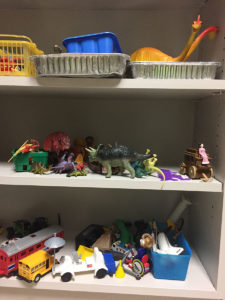
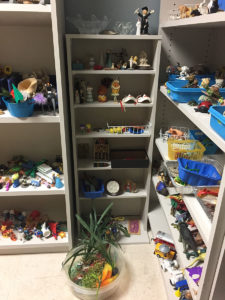
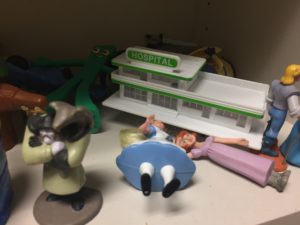
Plus 4 more bookshelves…
Note: We intend to place the large vertical shelves with longer horizontal shelves. Even with a foot ladder, our smaller kids have trouble reaching miniatures on the top shelves.
- *Also, please be very cognizant of the importance of placing toys in appropriate places developmentally (younger on the bottom, older towards the top).
- To see a list of symbols that I will be referencing, click here. This is not a complete list, and I encourage you to continue to explore for additional interpretations and meanings (keep in mind variances in cultures!).
- Also, be very careful of transferring your own meaning on a symbol! Sometimes a therapist will get stuck on literal meanings of symbols and try to make their own interpretations. The client knows, and the client is working. That is what is important. Experts will advise you to never interpret a tray to the client. Instead, I always ask my clients to name their tray, and I ask if there is anything they would like to share about the tray. You can become more directive if you choose such as asking the client who is in the tray and for example, “If you could place yourself anywhere in this tray, where would you go? Who would you talk to? How does this tray feel?” Take a picture of the tray and make your interpretations after the client leaves.
It is imperative that I begin with mentioning what an archetype is (as you’ll see the word strewn about this article in various places).
“Archetypes are not inborn ideas, but “typical” forms of behavior which, once made conscious, present themselves as ideas and images, like everything else that becomes a content of consciousness.” –http://www.astramate.com/mytholog.htm
Anyway, now to the good stuff… how to organize a sandtray room! With before and after photos!
1. Transportation and Structures
From bottom to top:
- Cars, Planes, and Boats. Vehicles are important symbols that represent movement and mobility. Vehicles also can represent empowerment, or the opposite- stuck! We also have a crashed car miniature (a broken matchbox car).
- Occupational Vehicles. On this shelf, I put occupational and work vehicles with road signs. Road signs can have literal meanings (e.g., stop, go, “do not enter,” etc.) or can the client can have a totally different interpretation of what a sign could mean. Remember it isn’t our job to place a meaning on a symbol.
- Manmade Structures. Man-made structures can include fences, bridges, wishing wells, etc. All of these are extremely important to include in your collection as they can represent structure (obviously), boundaries, limitations, protection, or entrapment. A well can represent nourishment or energy being gathered from the unconscious.
- Misc. Structures. Sometimes you’ll have miniatures that are important symbols that can represent archetypes (stereotypes) within a client, but you’re not sure where they’d fit best. As long as it makes sense to include them on the same shelf (a common theme), it is okay to have a shelf of misc. items that belong to that theme. On my misc. structures shelf, I included symbols of light (illumination of unconscious), and buckets and pails (items that can have water/sand poured into them).
- Buildings & Jails. Finally, on the top two shelves, I included manmade buildings and jails. I’ve had clients place their perpetrators in jail (or themselves) and can be so important during the child’s healing process and aids in their ability to process their traumas. It can also provide them with an opportunity to play out a different or ultimate ending in their stories.
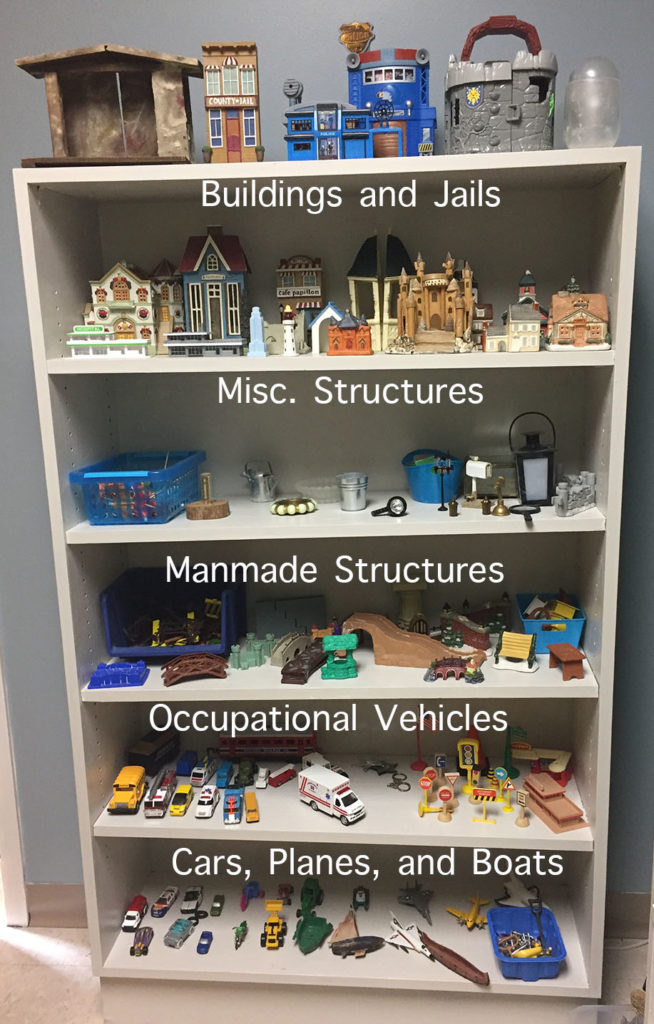
2. Animals and Fantasy
From bottom to top.
I’ll start off by saying this bookshelf is way too high. Our smaller clients have a hard time reaching miniatures up high even with a foot ladder. I recommend horizontal, long shelves instead of tall shelves.
- Safari & Wild Animals. Animals each have different symbolic meanings and those meanings vary across cultures. I decided to group safari and wild animals together as they tend to represent primitive, wild archetypes.
- Domesticated & Sea. I would’ve liked to dedicate an entire shelf to sea animals (and will once the bookshelves are replaced with horizontal shelving) because they can represent important archetypes in a client’s unconscious (dolphins tend to represent intelligence and instinctual guidance, while turtles can be a symbol of abandonment). Be sure to include little miniatures as well as larger miniatures of the same animal to represent families.
- Birds. I dedicated an entire shelf to birds because they are important symbols often representing spirituality and freedom. It is said that different birds carry different symbolic meanings. Click here for a great list of bird symbols. This is also another important time for me to again stress the importance of cultural variances in symbolism. For example, to the West, an owl can represent wisdom and intelligence. To the Apache, for example, an owl can represent death and to the Cherokee, sickness and punishment. For a great article on the symbolism and mythology of owls, click here.
- Dinos & Reptiles. Getting more primitive as we go higher up. A lot of clients have inner turmoil and rage. It is important to provide symbols that can express these unconscious urges. Dinosaurs tend to represent these unconscious rages. I included spiders, snakes, turtles, lizards, etc.
- Dragons & Unicorns. Some people devote entire shelves to dragons. Dragons can represent something overpowering to be overcome. Dragons can also represent guardians of something sacred (be sure to have a shelf with some treasure!). Unicorns, on the other hand, can represent purity, innocence, and childhood. According to Jung, unicorns are representations of the self.
- Fantasy People. Included on this shelf are wizards (the representation of the 4 functions of the human psyche- intuition, sensation, feeling, and thinking), fairies, princesses and princes, and mermaids.
- Fantasy Structures. Castles often symbolize structure and safety along with grandiosity. Here we included wishing wells and treasure (later added more).
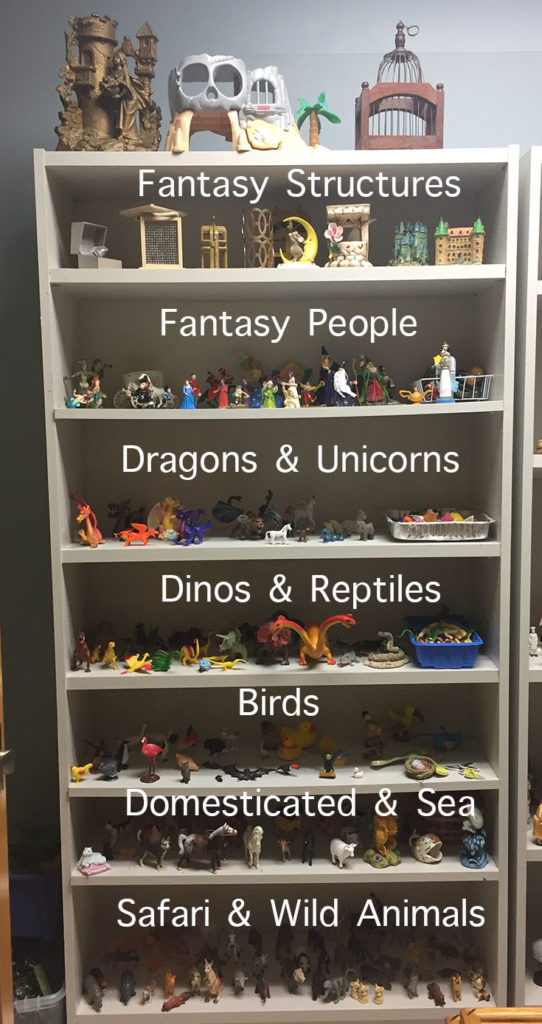
3. People
From bottom to top.
(Sorry for the bad angle- the tray is in front of this shelf)
- Men. We decided to arrange the People miniatures by gender so the client can easily navigate the bookshelf. Men can represent the father figure- power, guidance, security, or the opposite: a perpetrator, evil, etc. It’s up to the client!
- Women & Children. Women can also resemble nurturance, guidance, security. Women can also represent abandonment or a perpetrator of a client. Children can represent innocence and can be used as an expression of the self. A child could also use this to represent a sibling, a loss of innocence, or perhaps to represent another child perpatrator. It is again important to include different sizes of miniatures as well as families.
- Occupations and Hobbies. Occupations and hobbies are important ways we sometimes choose to represent ourselves or others. For example, a client who has a policeman for a father may choose the policeman to represent him. Or a client who has had a policeman involved in his trauma story may include a policeman for that purpose.
- Cultural. On the cultural shelf, we have different cultures (some not in the photo) such as Native Americans and Egyptians. These could represent something foreign to the client, or perhaps part of his/her heritage.
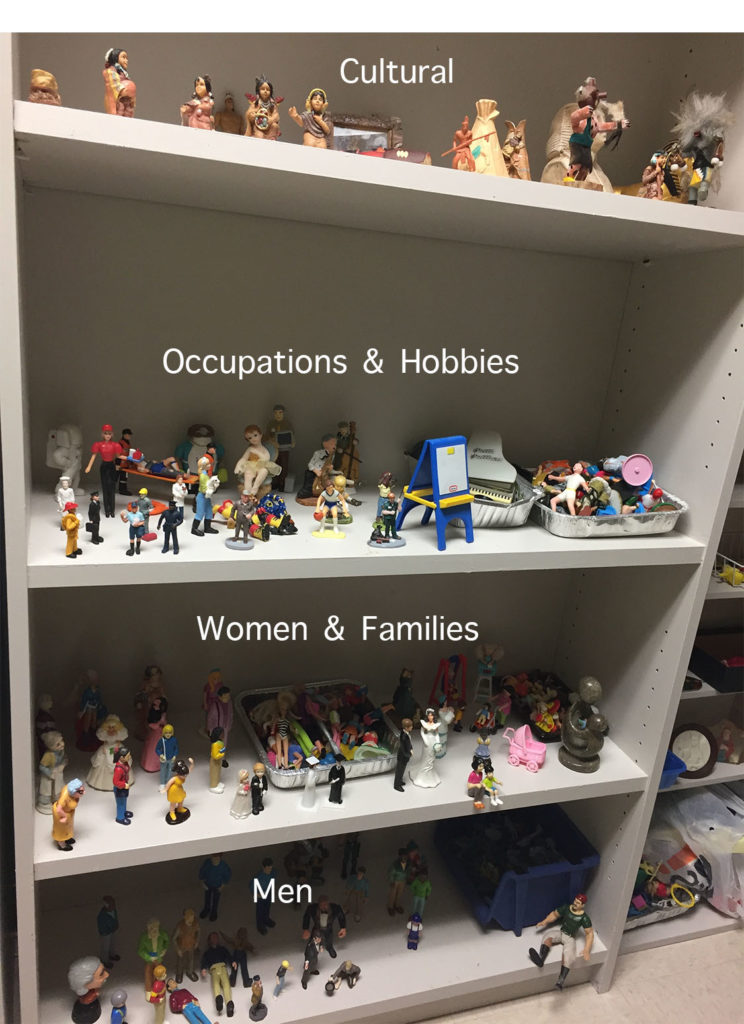
4. Nature Items
From bottom to top.
- Natural items. This includes rocks, shells, pine cones, and feathers. Shells tend to express relationship to feminine archetypes. They are also fragile items. Feathers can be spiritual symbols and used by Native American Chiefs to symbolize their communication with Spirit.
- Elements. We included a shelf with elements and structures including rainbows, volcanoes, a snowscape, and some underwater structures. Weather elements can be fundamental ways to express the unconscious, and we later added a lightning bolt. Underwater structures (found in your local pet store, aquarium section) can represent submersion (repression) of the unconscious.
- Trees & Misc. The “misc.” includes wooden blocks, boxes, and flowers. Flowers tend to represent rebirth and transformation. Trees can symbolize growth and life.
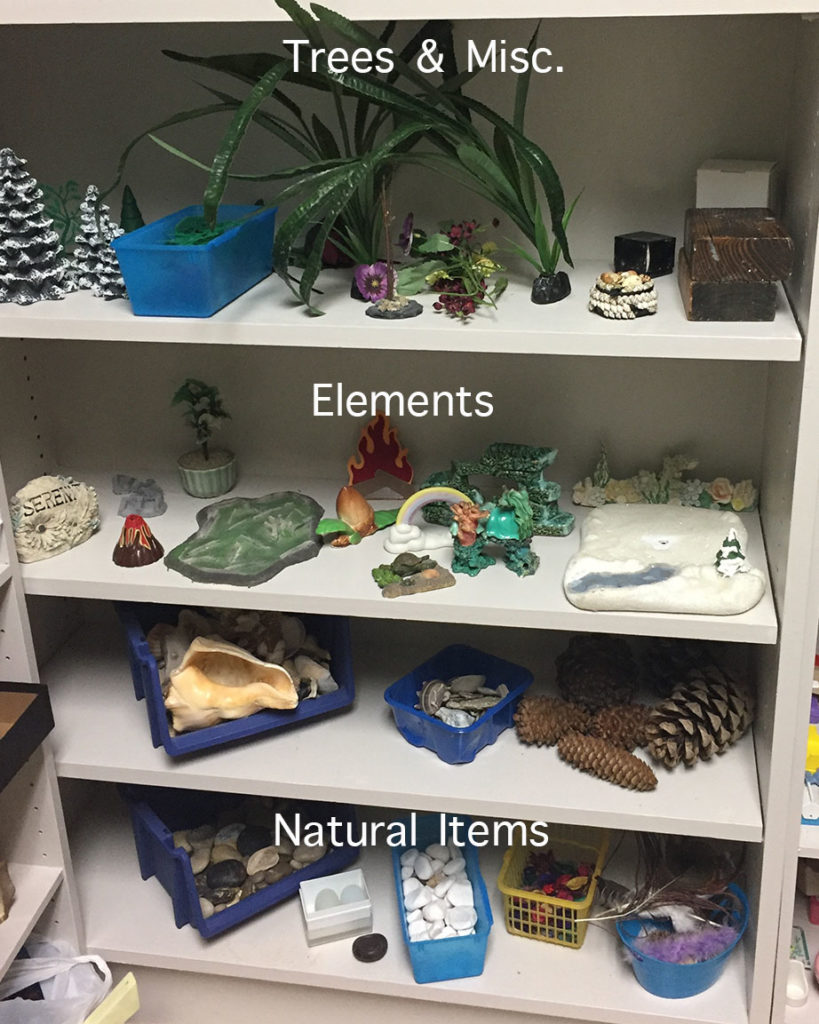
5. Spiritual & Scary
From bottom to top.
(This shelf is higher up and it is recommended based on the developmental organization of your sand room, that it is. Some people also choose to separate these two categories.)
- Spiritual. Included on the spiritual shelf are symbols of Christianity such as Jesus (death and resurrection), angels (protection) as well as different religious symbols.
- Scary. The scary shelf is just that- doom and gloom. Troubled miniature people, gangsters, skeletons, guns, you name it.
And more to come!
This task took about 5 hours to complete. We still have some shelves available and more symbols to sort through, but we wanted to get some of the major ones out of the way.
For those interested in what a sandtray looks like… here is one of mine!
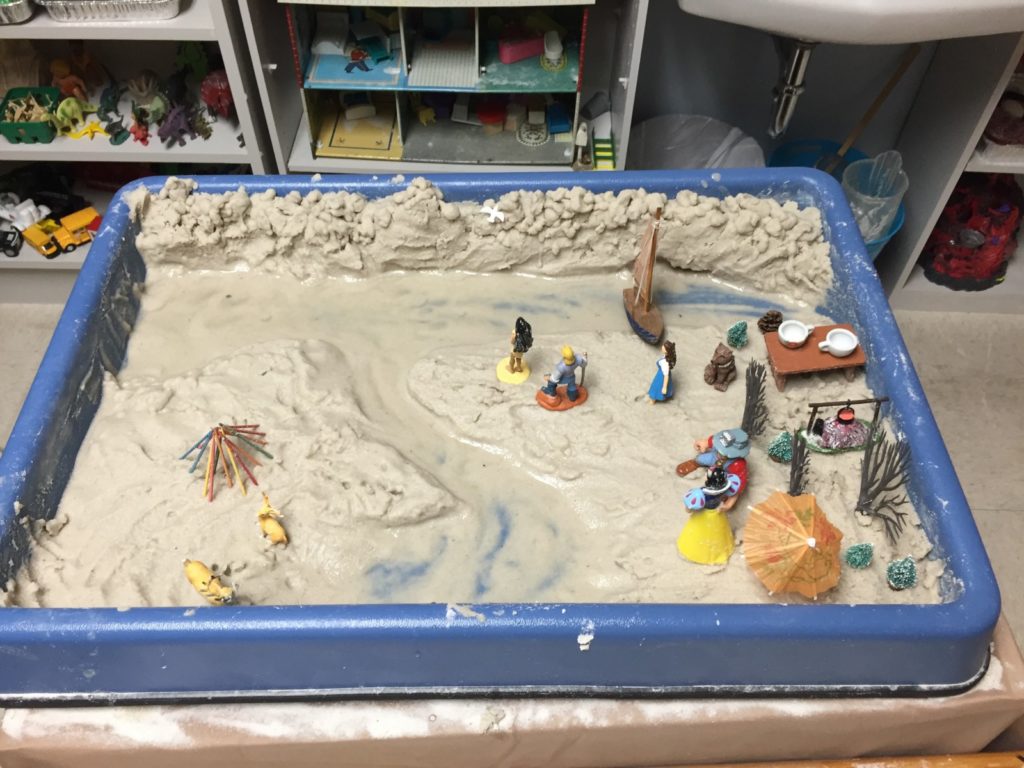
Want to interpret it? 😉
The articles:
- Jungian Sandplay history and explanation: http://www.junginla.org/education/what_is_sandplay.
- Water in sandplay: http://www.e-jsst.org/upload/jsst-5-30.pdf
- List of Symbols: http://creativesocialworker.tumblr.com/symbols
- About Archetpyes: http://www.astramate.com/mytholog.htm
- Bird Symbolism: http://mythsymbolsandplay.typepad.com/my-blog/bird-symbolism/3
- Symbolism and Mythology of Owls: http://www.owlpages.com/owls/articles.php?a=62

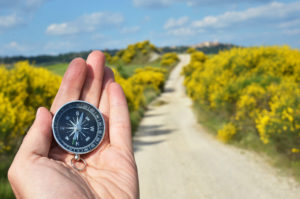
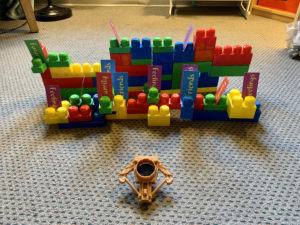

I really like this blog post. I have been wanting to rearrange the miniatures in the office i work in.
So glad you found it helpful! Thanks, Kim!
Pingback: Play Therapy with Adults | The Play Therapist
Pingback: How to Organize a Portable Play Therapy Kit | ThePlayTherapist.com
Pingback: Play Therapy with Adults
Thank you. I’m in the process of relocating my sandroom and couldn’t find the info on how to organize it.
Thank you so much, i am setting up sandtray shelves and this was so helpful!